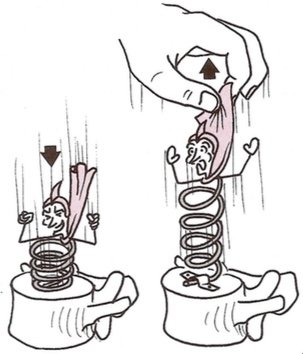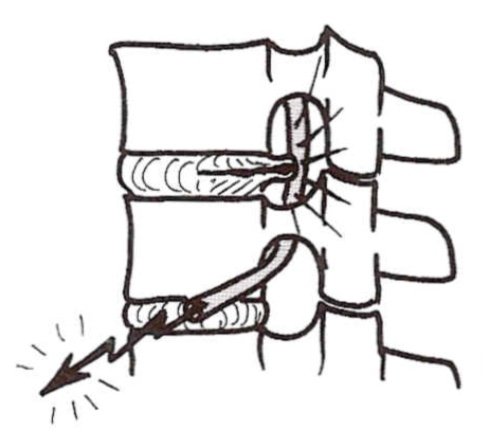The ELDOA™ & Scoliosis, Back Pain, Disc Herniation & Spinal Problems
What is ELDOA™ and why you really need a qualified professional to learn it properly.
The ELDOA™ Method is a revolutionary exercise technique aimed to address postural dysfunctions, back pain, disc hernias, osteoarthritis and scoliosis. It works by self-induced myofascial tension where the subject engages in a very precise posture that solicits a specific fascial chain that is in link with the targeted joint segment making it the centre of separating forces. Each ELDOA™ posture is assigned to a joint segment and engages a different fascial plane. In fact, you can be very accurate with these exercises. By knowing the exact problem and its specific location, an experienced ELDOA™ practitioner should be able to isolate and address that body segment with a specific ELDOA™ exercise.
This approach emphasises the interconnectedness of the fascial system, helping to enhance overall mobility and reduce pain. Practitioners often report significant benefits in chronic conditions, making ELDOA™ a valuable tool for therapeutic applications.
Guy Voyer, the creator of ELDOA™, is a French osteopath and educator renowned for his contributions to the understanding of fascia and its role in physical health. Voyer developed ELDOA™ in the late 20th century, integrating his extensive knowledge of anatomy, biomechanics, and osteopathy to create a system that addresses both the physical and functional aspects of body alignment. His work continues to influence practitioners and therapists globally, underscoring the importance of functional movement in achieving long-term wellness.
Some key benefits of ELDOA™ include:
Improved Spinal Alignment: ELDOA™ exercises help to restore proper alignment of the spine, reducing stress on the vertebrae and surrounding tissues.
Enhanced Joint Mobility: Regular practice of ELDOA™ can increase the range of motion in joints, facilitating better movement patterns and reducing the risk of injury.
Pain Relief: By focusing on decompression of the spine and joints, ELDOA™ can alleviate chronic pain and discomfort associated with conditions like sciatica, herniated discs, and lower back pain.
Postural Correction: ELDOA™ encourages awareness of body mechanics, helping clients to develop better postural habits that can prevent future issues.
Increased Body Awareness: These exercises cultivate a deeper connection between the mind and body, promoting mindfulness and better self-regulation of physical movements.
Support for Athletic Performance: Athletes can benefit from improved flexibility, strength, and injury prevention, enhancing their overall performance. ELDOA™ is a very effective recovery tool due to its effect on the autonomic nervous system.
SCOLIOSIS & the ELDOA™
“Scoliosis is a condition in which the spine bends to the side abnormally; either to the right or left. The curvature can be moderate to severe. Any part of the spine can be bent in scoliosis; but the most common regions are the chest area, thoracic scoliosis, or the lower part of the back, lumbar scoliosis.”
While these explanations may be useful for layperson to identify someone with scoliosis it doesn’t unfortunately say much about how this condition forms and what can be done about it.
From a mechanical point of view, the origin of scoliosis lies within the rotation of the vertebrae. Due to the orientation of articular surfaces of the vertebral joints (facet/zygapophyseal joint), when the vertebra rotates both on the intervertebral disc and the facet, side bending occurs in the spine. If the rotation is not corrected, the side bending is there to stay. That is the basic mechanics of scoliosis.
In many cases people with scoliosis develop two curves. The first one is the primary curve, and then a secondary curve, which is often the curve of compensation. This often occurs because of our instinct to maintain our eyes level with the horizon.
If our aim is to improve the scoliosis, we need to focus on addressing the rotation. We need to consider the alignment of the pelvis and how the sacrum sits between the two ilia.
Often times, the patient needs a very precise structural correction of the rotation of the vertebrae. To maintain the correction and to further improve the alignment of the spine, spinal ELDOA™ needs to be practiced for the segments of where the beginning, the middle and the apex of each curve is.
Designed by Guy Voyer himself, the ELDOA™ utilize myofascial tension to create a centre of “separating forces” around a primary lesion. As we can target the tension to isolate a specific segment the benefits of this exercises are both local and global.
Locally, there is targeted stimulation of intrinsic muscle action in a "long" range which affects not only the muscle but the joint capsule and the surrounding ligaments, resulting in better proprioception and awareness of the segment.
The fascial tension affects the diameter of the blood vessels resulting in an increase in blood flow while it provides a mechanical stimulation for the symphatetic trunk ganglia, which are anterolateral to the vertebral body, bringing about a neurohormonal normalisation. The release of compression on the segment result in increased joint range of motion, reduced intervertebral disc pressure and a stimulation of the water uptake of the disc, while having a positive effect on the peripheric nerves and structures that the given segment supplies.
This targeted isolation is achieved in a global posture where various myofascial chains are engaged and worked simultaneously resulting in normalisation of muscles tone within the chain and an improved balance and coordination between the various myofascial chains.
The by-product of this is often less pain, better posture, and an increased sense of well-being.
Once learned, each ELDOA™ exercise takes a minute or two to perform, meaning if you have a single curve, take 5-10 minutes a day and you can continuously improve your scoliosis. If you have a double curve, in 10-15 minutes a day you can improve and eventually correct the functional part of your scoliosis, which is basically the muscular and soft tissue adaptation to the misaligned body structure.
In what time frame you can expect to correct a scoliosis?
Dr Voyer suggests it will largely depend on the degree of curve and the age of the person.
In his experience you can completely correct the scoliotic spine of the growing child and adolescent while the adult person could only expect an approximate 50% correction, which is approximately the functional part of the scoliosis.
If not corrected in time, the long-term consequences of scoliosis can include pain, osteoarthritis, functional limitation of the viscera affecting;
-the lungs due to the modification of the shape of the thoracic cage,
-the heart due to the retraction of the pericardium,
-the liver, the pancreas and the spleen via their connection wit the diaphragm and so on.
Although the practice of ELDOA™ is a very effective and unique way of treating scoliosis, yet it is not a quick fix. While its benefits are often felt immediately, it still needs to be practiced over months and continue them throughout the years to have an impact on the structural changes of the young growing spine.
But if that’s what it takes to avoid the negative consequences that scoliosis can bring about, if one can comprehend what these consequences mean to somebody’s health and quality of life…. I’m sure one will willingly take an extra few minutes a day.
The question is when are you going to start?
Peter integrates ELDOA™ in London into our practice tailored to each client's specific needs. Each session includes detailed instruction on the correct execution of ELDOA™ postures, ensuring clients can derive maximum benefit from the practice. He emphasises the importance of consistency and provides ongoing support to help his clients and patients make ELDOA™ a regular part of their self-care and wellness routine.
Back Pain, Disc Herniation & Spinal Problems
Back pain is one of the highest reported reason for medical absence of work. Statistically speaking, if you picked a random group of people off the street to have a large enough sample and put them in an MRI scan, quite a high percentage of them, somewhere between 1/3 and 3/4 would have a clinically significant findings on the scan that the radiologist would consider worthy to report on but only a few of them would present with actual symptoms.
The most common spinal levels where the discs seem to wear out the most is at the L5/S1 and L4/5 in the lumbar spine and the C5/6 levels in the cervical.
Illustration of a nerve root compression
This often results in the changed mechanics of the motion segment, with the disc impinging on the exiting nerve root, the reduced disc height changes facet joint mechanics etc. often resulting in pain and impaired function.
There are various reasons why that may be, couple of which are:
- We live a more sedentary lifestyle and lack of activities that conditions the tissues to be supported and more resilient to wear and tear -after all the body adapts to pressure and tension so lack of it poses a"de-conditioning" effect.
- From a biomechanical perspective L5/S1 is positioned like a wedge between the sacrum and the lumbar spine which carries and bears the weight of the superincumbent upper body, while the C5/6 is one of the first couple cervical segment where there is a transition between the relative "rigidity" of the upper thoracic spine and ribcage to the suddenly free neck. The movement in range most predominant in the cervical spine is flexion-extension which can be significantly exacerbated by today's text neck/forward head posture at the base of which sits C6 where the load exponentially increase with each extra centimeter of extra forward head carriage.
Therefore, I think it is worth having the presupposition when dealing with a new patient that they might have wear and tear in their spine, even if they don't report any symptoms.
While the patients concern is to become pain free as soon as possible, we as therapists have to do our best to address it as such to prevent the condition from becoming a chronic issue.
I find it important to look at how the body as a whole as well as its parts are being managed statically and dynamically relative to the centre of mass, as it shows where the weak points are, what segments get more stress, whether that extra stress is being dissipated and shared effectively between the joints of the kinetic chain and so on.
This often brings up the need for postural reprogramming to improve movement mechanics in order to learn to better manage it mass statically and dynamically movement mechanics
Among various manual soft tissue techniques and corrective exercise strengthening one very effective treatment, as well as preventative exercise tool that I teach all my patients, is the ELDOA™.



